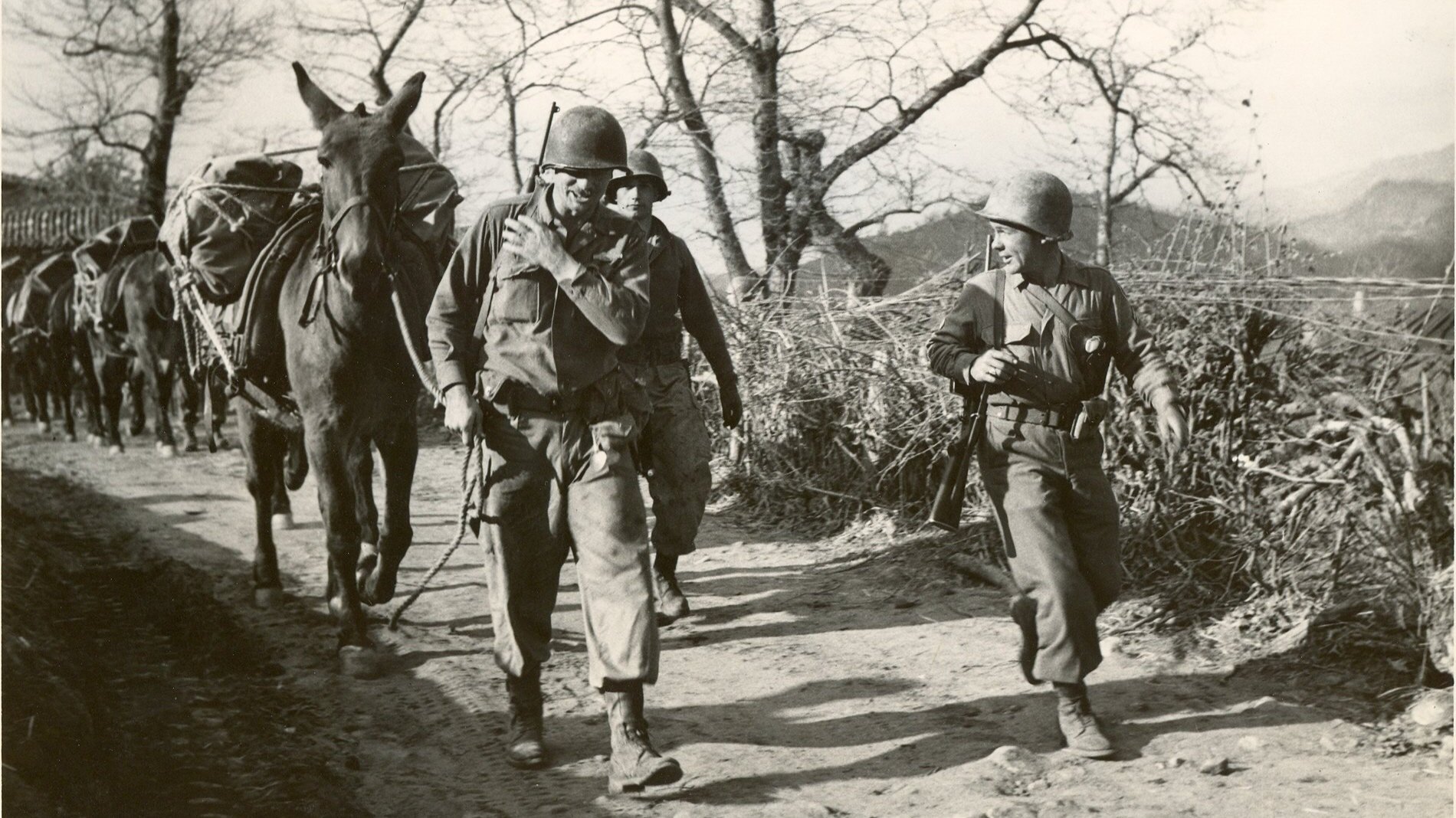10th Mountain Division Legacy Weekend in Honor of the 77th Anniversary of the Battle of Riva Ridge
In honor of the 77th Anniversary of the Battle of Riva Ridge, the Colorado Snowsports Museum, the Town of Vail, and Vail Resorts invites you to join us in learning more about the history of the 10th Mountain Division ski troopers and their lasting legacy. Legacy Weekend will kick off Friday, February 18th and end Sunday, February 20th.
Legacy Weekend Schedule - February 18-20, 2022:
David Little: Historian with the 10th Mountain Division Living History Display Group and the Foundation.
Daily 11am-6pm, stop by the Colorado Snowsports Museum (CSM) to see our 10th Mountain Division exhibition and catch the film “Climb to Glory,” playing on repeat in our theater.
Friday, February 18, starting at 4pm, join us at the CSM for Tales of the 10th with special speaker David Little, well known historian with the 10th Mountain Division Living History Display Group, as he dives into the history of the 10th.
Friday, February 18, 6pm, brought to you by the Town of Vail and Vail Resorts, Legacy Day Parade and torchlight ski down start at 6PM at the base of Gondola One. Museum will be open until 8PM on Friday night.
Saturday, Feb 19, join us on Vail Mountain for the Riva Ridge Memorial Ski Down starting at the Legacy Hut - Top of Chair 4. Begins at 11am.
Saturday, Feb 19, Troopers Cup Race at 3:30pm. Pepi's Face - Vail Village.
Saturday, February 19, starting at 5:30pm (for in-person) and 6pm (virtually): Our next “Through the Lens” program at the CSM presented by Chris Anthony, Colorado Snowsports Hall of Fame inductee, Guide, Filmmaker, & founder of Chris Anthony Youth, will be a look into the past at one of World War II’s most decisive battles - the Battle of Riva Ridge. Get your tickets HERE.. Please also note: Link to join via Zoom will become available - day of the event - on our website home page at www.snowsportsmuseum.org.
Sunday, February 20, at 11am there will be a Blackhawk Helicopter Landing at the top of Chair 2 on Vail Mountain (Weather Dependent).
77th Anniversary of the Battle of Riva Ridge
When you hear “Riva Ridge,” what first comes to mind? Do you think of the ever popular and longest run at Vail? Maybe you think of long-time Vail resident and 10th Mountain Division veteran Jack Tweedy’s horse? Or do you long for a pint of Holidaily Brewing Company’s Riva Stout? Have you ever stopped to wonder why “Riva” is so often used as a name? The history behind these names goes back to World War II and the legendary 10th Mountain Division troops. With the 77th Anniversary of the Battle of Riva Ridge approaching on February 18th, the Colorado Snowsports Museum wants to share why this battle was a significant achievement during World War II.
At the end of 1944, the Allies’ 16-month war struggle had left Italy in shambles, and the Germans were prepared with artillery batteries around the country. The Allies were unable to break the German Gothic line across the top of Italy’s boot, measuring eight miles deep by 108 miles wide. From atop a series of high ridges, the Germans controlled all the high ground, could see attacks coming, prepare defenses, and prevent the Allies from moving into the rest of Europe.
By mid-January of 1945, the 14,000 men of the 10th Mountain Division had quietly moved into small villages surrounding these ridges in the northern Apennines area and began planning possible routes up Riva Ridge. This ridge held the German observatory post and was therefore crucial to defeating the rest of the Germans in the area and breaking their Gothic line.
The men assigned to the Riva Ridge operation found five routes up the 2,000-foot vertical cliff, the most difficult of which required ropes and pitons. Ironically, the specialized equipment that the 10th had developed and tested was back in the United States. The Germans believed that the steep slopes and cliffs of Riva Ridge could not be climbed, and the ridge was unassailable. The men of the 10th would prove the Germans wrong.
Vital to this operation was completing it at night, without artillery fire and as quickly as possible. As the sun set on February 18, 1945, 700 men congregated on Riva Ridge, while the rest of the division waited to take Mount Belvedere the next night. Carrying weapons, ammunition, climbing gear, and provisions, the 10th scaled the snow- and ice-covered slopes of Riva Ridge. As the soldiers worked their way up, a fog set in, concealing their positions.
What worried Dave Rankine, a veteran of the Riva Ridge operation, “was the fact that normally we have just one medic with us. And this time, we’ve got about five or six medics, and I thought, they’re expecting a lot of us to get wounded and killed.” Another 10th veteran, Howard Koch, recalls his anxiety that “we just went up in a single file, and therein lied the danger – that if we were discovered before we got up there, it could’ve been a very disastrous situation because we didn’t have room to deploy…”
When the men pushed up over the ridge and began their attack, “the Germans were back in dugouts sleeping and our troops took the guns over, turned them around and went down and threw hand grenades in their sleeping quarters and that’s the way they woke up,” Lt. General John Hay states. The Germans were awfully surprised at the American soldiers ascending from a side that had been declared “unclimbable.”
Hugh Evans
German counterattacks were to be anticipated, so Allied engineers designed a tramway system to evacuate wounded soldiers and transport supplies and ammunition to the troops. For five long days, the 10th held off counterattacks that killed seventeen and wounded 51 Americans. Finally, the critical observation post was in Allied hands and the battle continued for Mount Belvedere, Mount Gorgolesco, and Mount Della Torraccia.
As soldiers fought their way up the mountain, artillery and mortar fire intensified. Near the top of Mount Gorgolesco, Hugh Evans said machine gun fire took down his platoon sergeant. Hugh placed an air-tight bandage over the wounds on his chest. But in Hugh’s arms, with his good friend "Mac" MacKenzie by his side, the sergeant died. Enraged, Hugh charged to the top of Mount Gorgolesco, where he successfully, single-handedly, destroyed two German machine gun nests.
"We were so dead tired that you really didn't know what was going on," said Hugh Evans, who took over as platoon sergeant. "I remember having to go to shake some of the guys. They were so tired; I didn't know whether they were dead or alive."
This image shows Hugh Evans - post War. Hugh sadly passed away November 28, 2021 in Boulder.
Hear Hugh tell his own story through an oral history video provided by the American Veterans Center.
The victory of Riva Ridge was significant because it prevented the Germans from surveying the Allied troops and prevented the Germans from advancing. This was the first victory for the 10th in a series of other battles to come. "Riva Ridge and the battle on Mt Belvedere proved the concept that was the 10th Mountain Division. It also put the German army on notice that new soldiers - unlike any they had encountered before - were entering the battle.” explains David Little, Military Historian for Tenth Mountain Foundation. He goes on to say: “The 10th would come up against some of the best soldiers of the German army. These were battle hardened veterans of the Russian front, and some were highly trained German mountain soldiers. In their short exposure to combat, these ‘new’ soldiers pressed their attacks, took every objective, and never gave an inch of ground. We should not be surprised that these same young soldiers came home to start families and businesses, and conquered the challenges of skiing, mountaineering and anything else they tried their hand at. Their motto then and today ‘Sempre Avanti’ or Always Forward.”
With Riva Ridge secured, the assault on Mount Belvedere began on February 19 when 13,000 soldiers of the 10th launched an assault on the mountain. Facing heavy machine gun and mortar fire, the 10th took control of the mountain on February 23. Allied commanders had expected the battle for Riva Ridge and Mount Belvedere to last at least two weeks. The men of the 10th completed the mission in five days.
For the next two and a half months, the 10th pushed north through the Apennine Mountains. After five days of heavy combat, the 10th was the first unit to reach and cross the strategically important Po River, forcing the German army to retreat. As the 10th advanced, it fought in and liberated several towns from the Germans. The 10th was next charged with capturing Italian dictator Benito Mussolini’s villa on Lake Garda and the headquarters of his Italian Social Republic government in Salo.
The next time you see or hear “Riva Ridge,” we hope you to take a moment to remember the many sacrifices made by the 10th Mountain Division soldiers. While more and more of our World War II veterans are passing, it is more important than ever to continue to share their stories.
We invite you to stop by the Colorado Snowsports Museum to learn more about the 10th history and legacy through our permanent exhibition “Climb to Glory.” In honor of the anniversary of the Battle of Riva Ridge, the Colorado Snowsports Museum will also host two 10th Mountain Division related events: Tales of the 10th and Through the Lens presented by Chris Anthony. Check out our website or follow us on social media to learn more about 10th related events at the Museum, https://www.snowsportsmuseum.org/programs-events.
About the Colorado Snowsports Museum and Hall of Fame:
Founded in 1975 and located in Vail, Colorado, our mission is to celebrate Colorado snow sports by telling stories that educate and inspire others to seek adventure. The priceless artifacts we collect and display tell the story of the birth, rise and explosion of skiing and snowboarding in Colorado. The Museum features displays including “Climb to Glory” about the 10th Mountain Division, “Vail’s DNA,” The Colorado Snowboard Archive, and The Colorado Snowsports Hall of Fame, among many others. Learn more and consider supporting the Museum by becoming a member: https://www.snowsportsmuseum.org.
Our exhibit “Climb to Glory” celebrates the famed 10th Mountain Division, the mountain troopers of World War II. Learn the inspiring story of the 10th and view equipment and gear used by the troopers in both training at Camp Hale and in battle in Italy. This display is one of the most comprehensive 10th Mountain Division exhibits in the world. At the end, stay a little longer and watch “Climb to Glory” a 10th documentary made in collaboration with the Colorado Snowsports Museum, Warren Miller Entertainment, and Chris Anthony.
Sources:
• David Leach’s 2005 senior thesis for Middlebury College, “The Impact of the Tenth Mountain Division on the Development of a Modern Ski Industry in Colorado and Vermont: 1930-1965.”
• “Fire on the Mountain,” First Run Features/Gage & Gage Productions, 1995.
• “The Last Ridge,” Abbie Kealy, 2007.
• Colorado Snowsports Museum and Hall of Fame archives
More resources on the 10th Mountain Division can be found HERE.








